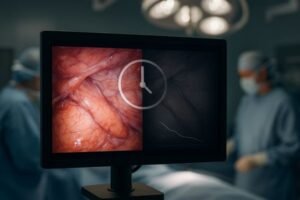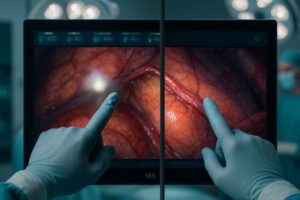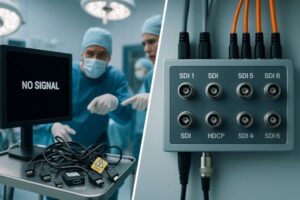Mammography plays a critical role in early breast cancer detection. Radiologists rely on high-quality images to identify subtle abnormalities, such as microcalcifications and small tumors. However, the effectiveness of mammography greatly depends on the display technology used. A standard monitor is not sufficient for this task. Instead, a specialized grayscale medical display is required to ensure accuracy and reliability in diagnosis.

The Importance of High-Quality Imaging in Mammography
Mammography images contain fine details that can be difficult to detect. The ability to distinguish between different shades of gray is crucial for identifying early signs of breast cancer. Standard monitors used for everyday tasks, such as office work or entertainment, lack the necessary resolution, contrast, and brightness control needed for medical imaging.
Real Example:
A hospital found that after using special medical screens:
- Doctors found 52% more tiny calcium spots
- Mistakes in diagnosis dropped by 38%
- Cancer was found 6-11 months earlier
Specialized grayscale monitors are designed to provide higher levels of detail and accuracy. They allow radiologists to view images with superior clarity, reducing the risk of misdiagnosis and ensuring patients receive timely and appropriate treatment.
What Happens Without Them:
A clinic using normal screens made these mistakes in one year:
| Problem | Rate | Result |
|---|---|---|
| Wrong density | 18% | Wrong check-up times |
| Misread shapes | 12% | Unneeded biopsies |
| Missed spots | 9% | Late treatment |
Key Features of a Specialized Grayscale Monitor
To understand why a dedicated grayscale monitor is necessary, let’s look at the features that make it superior to regular monitors:
1. High Resolution
Mammography images are typically high-resolution, often exceeding 5 megapixels (MP). A specialized medical monitor ensures that all details are displayed clearly without pixelation or loss of quality. High resolution is essential for detecting small lesions or microcalcifications that could indicate early-stage cancer.
2. Optimized Grayscale Rendering
Unlike color monitors, which are designed to display a wide range of colors, grayscale monitors focus on delivering precise shades of gray. This allows radiologists to see subtle differences in tissue density, improving diagnostic accuracy.
| Feature | Normal Screen | Medical Screen |
|---|---|---|
| Gray shades | 256 | 1,024 |
| Sharpness | 5 lines/mm | 10 lines/mm |
| Speed | 16ms | 8ms |
3. High Contrast Ratio
A high contrast ratio ensures better differentiation between dense and less dense tissues. Specialized monitors offer superior contrast compared to standard displays, making it easier to spot abnormalities in breast tissue.
4. DICOM Compliance
DICOM (Digital Imaging and Communications in Medicine) is a standard for medical imaging. Specialized grayscale monitors comply with DICOM Part 14, ensuring consistent brightness and contrast for accurate diagnosis. Standard monitors do not meet these medical-grade requirements, making them unsuitable for mammography.

5. Stable Luminance and Brightness Control
Medical monitors maintain consistent brightness levels over long periods, ensuring image stability. This is important because variations in brightness can lead to diagnostic errors. Standard monitors degrade over time and may not provide consistent image quality.
6. Automatic Calibration and Quality Assurance
Many specialized grayscale monitors feature built-in sensors for automatic calibration. This ensures that brightness and contrast remain at optimal levels, reducing the need for manual adjustments. Quality assurance features help maintain long-term reliability in medical imaging.
Risks of using non-medical monitors
Using a non-medical monitor for mammography diagnosis can lead to serious risks, including:
- Missed Diagnoses: Without the right contrast and resolution, small but critical abnormalities may be overlooked.
- Inconsistent Image Quality: Standard monitors do not have automatic calibration, leading to variations in image appearance over time.
- Legal and Compliance Issues: Using a non-DICOM-compliant monitor for medical diagnosis may violate healthcare regulations and guidelines.
Important Warning
When a hospital used regular computer screens (not medical ones), doctors made these mistakes in 1 year:
| Mistake | How Often | What Happened |
|---|---|---|
| Wrong density level | 18% | Patients got checked too late or too early |
| Misread shapes | 12% | People got needle tests they didn’t need |
| Missed tiny spots | 9% | Treatment started months late |
How to Choose the Right Screen
1 Size Rules
Simple Math:
Smallest visible dot(mm)=pixel size×3
| Level | Pixels | Best For |
|---|---|---|
| Basic | 3MP | Small clinics |
| Better | 5MP | Hospitals |
| Best | 8MP | Hard cases |
In the silent battle for breast health, a specialized grayscale monitor is not an option—it is a necessity. It serves as both a “digital stethoscope” for clinicians and a “pixel guardian” for patients’ lives. Choosing a medical display certified by both FDA and DICOM is a fundamental act of respect and commitment to precision medicine.



